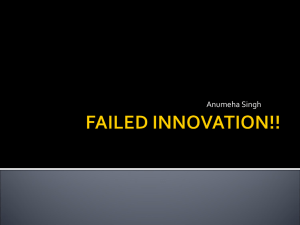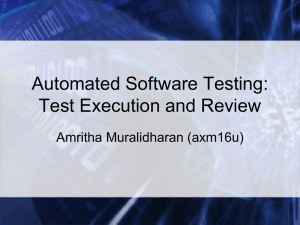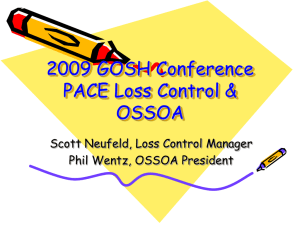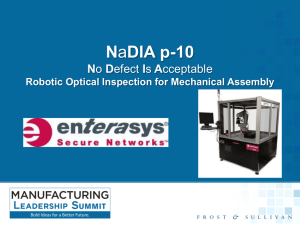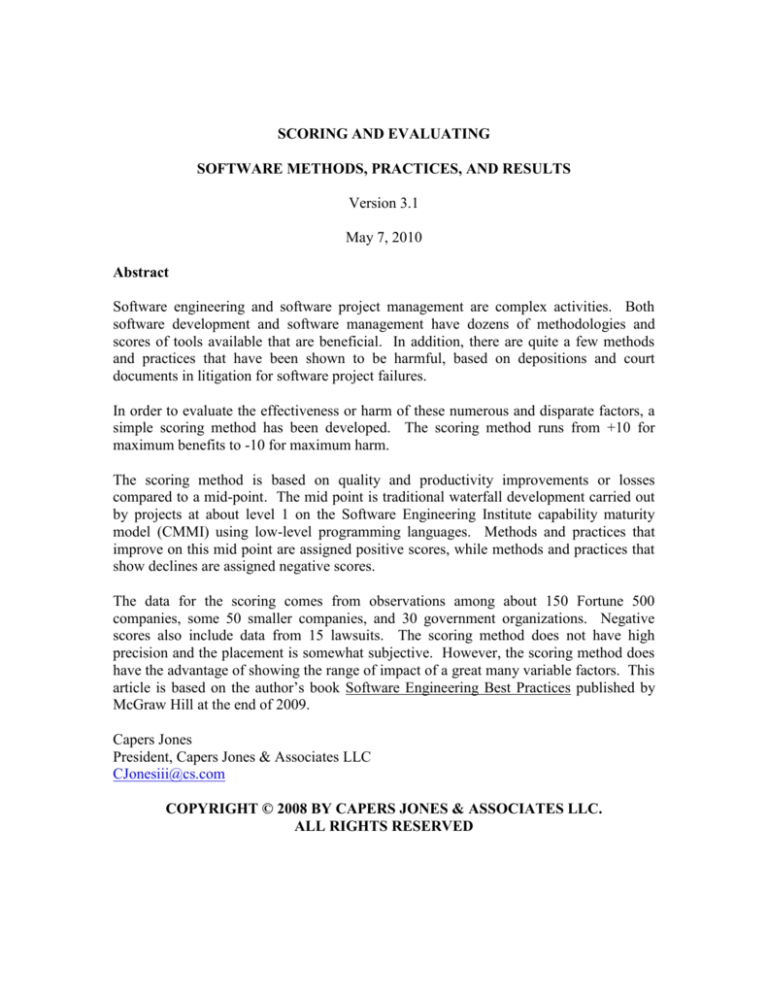
SCORING AND EVALUATING
SOFTWARE METHODS, PRACTICES, AND RESULTS
Version 3.1
May 7, 2010
Abstract
Software engineering and software project management are complex activities. Both
software development and software management have dozens of methodologies and
scores of tools available that are beneficial. In addition, there are quite a few methods
and practices that have been shown to be harmful, based on depositions and court
documents in litigation for software project failures.
In order to evaluate the effectiveness or harm of these numerous and disparate factors, a
simple scoring method has been developed. The scoring method runs from +10 for
maximum benefits to -10 for maximum harm.
The scoring method is based on quality and productivity improvements or losses
compared to a mid-point. The mid point is traditional waterfall development carried out
by projects at about level 1 on the Software Engineering Institute capability maturity
model (CMMI) using low-level programming languages. Methods and practices that
improve on this mid point are assigned positive scores, while methods and practices that
show declines are assigned negative scores.
The data for the scoring comes from observations among about 150 Fortune 500
companies, some 50 smaller companies, and 30 government organizations. Negative
scores also include data from 15 lawsuits. The scoring method does not have high
precision and the placement is somewhat subjective. However, the scoring method does
have the advantage of showing the range of impact of a great many variable factors. This
article is based on the author’s book Software Engineering Best Practices published by
McGraw Hill at the end of 2009.
Capers Jones
President, Capers Jones & Associates LLC
CJonesiii@cs.com
COPYRIGHT © 2008 BY CAPERS JONES & ASSOCIATES LLC.
ALL RIGHTS RESERVED
INTRODUCTION:
EVALUATING SOFTWARE METHODS, PRACTICES, AND RESULTS
Software development and software project management have dozens of methods,
hundreds of tools, and scores of practices. Many of these are beneficial, but many are
harmful too. There is a need to be able to evaluate and rank many different topics using a
consistent scale.
To deal with this situation a scoring method has been developed that allows disparate
topics to be ranked using a common scale. Methods, practices, and results are scored
using a scale that runs from +10 to -10 using the criteria shown in table 1.1.
Both the approximate impact on productivity and the approximate impact on quality are
included. The scoring method can be applied to specific ranges such as 1000 function
points or 10,000 function points. It can also be applied to specific types of software such
as Information Technology, Web application, commercial software, military software, and
several others.
Table 1.1 Scoring Ranges for Software Methodologies and Practices
Score
Productivity
Improvement
Quality
Improvement
10
9
8
7
6
5
4
3
2
1
0
-1
-2
-3
-4
-5
-6
-7
-8
-9
-10
25%
20%
17%
15%
12%
10%
7%
3%
1%
0%
0%
0%
-1%
-3%
-7%
-10%
-12%
-15%
-17%
-20%
-25%
35%
30%
25%
20%
17%
15%
10%
5%
2%
0%
0%
0%
-2%
-5%
-10%
-15%
-17%
-20%
-25%
-30%
-35%
2
The midpoint or “average” against which improvements are measured are traditional
application development methods such as “waterfall” development performed by
organizations that either don’t use the Software Engineering Institute’s capability
maturity model or are at level 1. Low-level programming languages are also assumed.
This fairly primitive combination remains more or less the most widely used
development method even in 2008.
One important topic needs to be understood. Quality needs to be improved faster and to a
higher level than productivity in order for productivity to improve at all. The reason for
this is that finding and fixing bugs is overall the most expensive activity in software
development. Quality leads and productivity follows. Attempts to improve productivity
without improving quality first are not effective.
For software engineering a serious historical problem has been that measurement
practices are so poor that quantified results are scarce. There are many claims for tools,
languages, and methodologies that assert each should be viewed as a “best practice.” But
empirical data on their actual effectiveness in terms of quality or productivity has been
scarce. Three points need to be considered.
The first point is that software applications vary by many orders of magnitude in size.
Methods that might be ranked as “best practices” for small programs of 1,000 function
points in size may not be equally effective for large systems of 100,000 function points in
size.
The second point is that software engineering is not a “one size fits all” kind of
occupation. There are many different forms of software such as embedded applications,
commercial software packages, information technology projects, games, military
applications, outsourced applications, open-source applications and several others. These
various kinds of software applications do not necessarily use the same languages, tools,
or development methods.
The third point is that tools, languages, and methods are not equally effective or
important for all activities. For example a powerful programming language such as
Objective C will obviously have beneficial effects on coding speed and code quality. But
which programming language is used has no effect on requirements creep, user
documentation, or project management. Therefore the phrase “best practice” also has to
identify which specific activities are improved. This is complicated because activities
include development, deployment, and post-deployment maintenance and enhancements.
Indeed, for large applications development can take up to five years, installation can take
up to one year, and usage can last as long as 25 years before the application is finally
retired. Over the course of more than 30 years there will be hundreds of activities.
The result of these various factors is that selecting a set of “best practices for software
engineering” is a fairly complicated undertaking. Each method, tool, or language needs
to be evaluated in terms of its effectiveness by size, by application type, and by activity.
3
Overall Rankings of Methods, Practices, and Sociological Factors
In order to be considered a “best practice” a method or tool has to have some quantitative
proof that it actually provides value in terms of quality improvement, productivity
improvement, maintainability improvement, or some other tangible factors.
Looking at the situation from the other end, there are also methods, practices, and social
issues have demonstrated that they are harmful and should always be avoided. For the
most part the data on harmful factors comes from depositions and court documents in
litigation.
In between the “good” and “bad” ends of this spectrum are practices that might be termed
“neutral.” They are sometimes marginally helpful and sometimes not. But in neither
case do they seem to have much impact.
Although the author’s book Software Engineering Best Practices, will deal with methods
and practices by size and by type, it might be of interest to show the complete range of
factors ranked in descending order, with the ones having the widest and most convincing
proof of usefulness at the top of the list. Table 1.2 lists a total of 200 methodologies,
practices, and social issues that have an impact on software applications and projects.
The average scores shown in table 1.2 are actually based on six separate evaluations:
1.
2.
3.
4.
5.
6.
Small applications < 1000 function points
Medium applications between 1000 and 10,000 function points
Large applications > 10,000 function points
Information technology and web applications
Commercial, systems, and embedded applications
Government and military applications
The data for the scoring comes from observations among about 150 Fortune 500
companies, some 50 smaller companies, and 30 government organizations. Negative
scores also include data from 15 lawsuits. The scoring method does not have high
precision and the placement is somewhat subjective. However, the scoring method does
have the advantage of showing the range of impact of a great many variable factors. This
article is based on the author’s book Software Engineering Best Practices now in
preparation for publication by McGraw Hill in 2009.
However the resulting spreadsheet is quite large and complex, so only the overall average
results are shown here:
4
Table 1.2 Evaluation of Software Methods, Practices, and Results
Methodology, Practice, Result
Average
1
2
3
4
5
6
7
8
9
10
11
12
13
14
Best Practices
Reusability (> 85% zero-defect materials)
Defect potentials < 3.00 per function point
Defect removal efficiency > 95%
Personal Software Process (PSP)
Team Software Process (TSP)
Automated static analysis
Inspections (code)
Measurement of defect removal efficiency
Hybrid (CMM+TSP/PSP+others)
Reusable feature certification
Reusable feature change controls
Reusable feature recall method
Reusable feature warranties
Reusable source code (zero defect)
9.65
9.35
9.32
9.25
9.18
9.17
9.15
9.08
9.06
9.00
9.00
9.00
9.00
9.00
15
16
17
18
19
20
21
22
23
24
25
26
27
28
29
30
31
32
33
34
35
Very Good Practices
Early estimates of defect potentials
Object-oriented development (OO)
Automated security testing
Measurement of bad-fix injections
Reusable test cases (zero defects)
Formal security analysis
Agile development
Inspections (requirements)
Time boxing
Activity-based productivity measures
Reusable designs (scalable)
Formal risk management
Automated defect tracking tools
Measurement of defect origins
Benchmarks against industry data
Function point analysis (high-speed)
Formal progress reports (weekly)
Formal measurement programs
Reusable architecture (scalable)
Inspections (design)
Lean Six-Sigma
8.83
8.83
8.58
8.50
8.50
8.43
8.41
8.40
8.38
8.33
8.33
8.27
8.17
8.17
8.15
8.15
8.06
8.00
8.00
7.94
7.94
5
36
37
38
39
40
41
42
43
44
45
46
47
48
49
50
51
52
53
54
55
56
57
58
59
60
61
62
63
64
65
66
67
68
69
70
Six-sigma for software
Automated cost estimating tools
Automated maintenance work benches
Formal cost tracking reports
Formal test plans
Automated unit testing
Automated sizing tools (function points)
Scrum session (daily)
Automated configuration control
Reusable requirements (scalable)
Automated project management tools
Formal requirements analysis
Data mining for business rule extraction
Function point analysis (pattern matches)
High-level languages (current)
Automated quality and risk prediction
Reusable tutorial materials
Function point analysis (IFPUG)
Measurement of requirements changes
Formal architecture for large applications
Best-practice analysis before start
Reusable feature catalog
Quality function deployment (QFD)
Specialists for key skills
Joint Application Design (JAD)
Automated test coverage analysis
Reestimating for requirements changes
Measurement of defect severity levels
Formal SQA team
Inspections (test materials)
Automated requirements analysis
DMAIC
Reusable construction plans
Reusable HELP information
Reusable test scripts
7.94
7.92
7.90
7.89
7.81
7.75
7.73
7.70
7.69
7.67
7.63
7.63
7.60
7.58
7.53
7.53
7.50
7.37
7.37
7.36
7.33
7.33
7.32
7.29
7.27
7.23
7.17
7.13
7.10
7.04
7.00
7.00
7.00
7.00
7.00
71
72
73
74
75
76
Good Practices
Rational Unified Process (RUP)
Automated deployment support
Automated cyclomatic complexity analysis
Forensic analysis of cancelled projects
Reusable reference manuals
Automated documentation tools
6.98
6.87
6.83
6.83
6.83
6.79
6
77
78
79
80
81
82
83
84
85
86
87
88
89
90
91
92
93
94
95
96
97
98
99
100
101
102
103
104
105
106
107
108
109
110
111
Capability Maturity Model (CMMI Level 5)
Annual training (technical staff)
Metrics conversion (automated)
Change review boards
Formal Governance
Automated test library control
Formal scope management
Annual training (managers)
Dashboard-style status reports
Extreme programming (XP)
Service-Oriented Architecture (SOA)
Automated requirements tracing
Total Cost of Ownership (TCO) measures
Automated performance analysis
Baselines for process improvement
Use cases
Automated test case generation
User satisfaction surveys
Formal project office
Automated modeling/simulation
Certification (six sigma)
Outsourcing (maintenance => CMMI 3)
Capability Maturity Model (CMMI Level 4)
Certification (software quality assurance)
Outsourcing (development => CMM 3)
Value analysis (intangible value)
Root-cause analysis
Total Cost of Learning (TOL) measures
Cost of quality (COQ)
Embedded users in team
Normal structured design
Capability Maturity Model (CMMI Level 3)
Earned-value measures
Unified Modeling Language (UML)
Value analysis (tangible value)
6.79
6.67
6.67
6.62
6.58
6.50
6.50
6.33
6.33
6.28
6.26
6.25
6.18
6.17
6.17
6.17
6.00
6.00
5.88
5.83
5.83
5.83
5.79
5.67
5.67
5.67
5.50
5.50
5.42
5.33
5.17
5.06
5.00
5.00
5.00
112
113
114
115
116
117
Fair Practices
Normal maintenance activities
Rapid application development (RAD)
Certification (function points)
Function point analysis (Finnish)
Function point analysis (Netherlands)
Partial code reviews
4.54
4.54
4.50
4.50
4.50
4.42
7
118
119
120
121
122
123
124
125
126
127
128
129
130
131
132
133
134
135
136
Automated restructuring
Function point analysis (COSMIC)
Partial design reviews
Team Wiki communications
Function point analysis (unadjusted)
Function points (micro .001 to 10)
Automated daily progress reports
User stories
Outsourcing (offshore => CMM 3)
Goal-question metrics
Certification (project managers)
Refactoring
Manual document production
Capability Maturity Model (CMMI Level 2)
Certification (test personnel)
Pair programming
Clean-room development
Formal design languages
ISO Quality standards
4.33
4.33
4.33
4.33
4.33
4.17
4.08
3.83
3.67
3.50
3.33
3.33
3.17
3.00
2.83
2.83
2.50
2.50
2.00
137
138
139
140
141
142
143
144
145
146
147
148
149
150
151
152
153
Neutral Practices
Function point analysis (backfiring)
Use Case points
Normal customer support
Partial governance (low risk projects)
Object-oriented metrics
Manual testing
Outsourcing (development < CMM 3)
Story points
Low-level languages (current)
Outsourcing (maintenance < CMM 3)
Waterfall development
Manual change control
Manual test library control
Reusability (average quality materials)
Capability Maturity Model (CMMI Level 1)
Informal progress tracking
Outsourcing (offshore < CMM 3)
1.83
1.67
1.50
1.00
0.33
0.17
0.17
0.17
0.00
0.00
-0.33
-0.50
-0.50
-0.67
-1.50
-1.50
-1.67
154
155
156
Unsafe Practices
Inadequate test library control
Generalists instead of specialists
Manual cost estimating methods
-2.00
-2.50
-2.50
8
157
158
159
160
161
162
163
164
165
166
167
168
169
170
171
172
173
174
175
176
177
178
179
180
181
182
183
184
185
186
187
188
189
190
191
192
193
194
195
196
Inadequate measurement of productivity
Cost per defect metrics
Inadequate customer support
Friction between stakeholders and team
Informal requirements gathering
Lines of code metrics (logical LOC)
Inadequate governance
Lines of code metrics (physical LOC)
Partial productivity measures (coding)
Inadequate sizing
High-level languages (obsolete)
Inadequate communications among team
Inadequate change control
Inadequate value analysis
Worst Practices
Friction/antagonism among team members
Inadequate cost estimating methods
Inadequate risk analysis
Low-level languages (obsolete)
Government mandates (short lead times)
Inadequate testing
Friction/antagonism among management
Inadequate communications with
stakeholders
Inadequate measurement of quality
Inadequate problem reports
Error-prone modules in applications
Friction/antagonism among stakeholders
Failure to estimate requirements changes
Inadequate defect tracking methods
Rejection of estimates for business reasons
Layoffs/loss of key personnel
Inadequate inspections
Inadequate security controls
Excessive schedule pressure
Inadequate progress tracking
Litigation (non-compete violation)
Inadequate cost tracking
Litigation (breach of contract)
Defect potentials > 6.00 per function point
Reusability (high defect volumes)
Defect removal efficiency < 85%
-2.67
-2.83
-2.83
-3.50
-3.67
-4.00
-4.17
-4.50
-4.50
-4.67
-5.00
-5.33
-5.42
-5.50
-6.00
-6.04
-6.17
-6.25
-6.33
-6.38
-6.50
-6.50
-6.50
-6.67
-6.83
-6.83
-6.85
-7.17
-7.33
-7.33
-7.42
-7.48
-7.50
-7.50
-7.50
-7.75
-8.00
-9.00
-9.17
-9.18
9
197
198
199
200
Litigation (poor quality/damages)
Litigation (security flaw damages)
Litigation (patent violation)
Litigation (intellectual property theft)
-9.50
-9.50
-10.00
-10.00
It should be realized that table 1.2 is a work in progress. Also, the value of table 1.2 is
not in the precision of the rankings, which are somewhat subjective, but in the ability of
the simple scoring method to show the overall sweep of many disparate topics using a
single scale.
Note that the set of factors included are a mixture. They include full development
methods such as Team Software Process (TSP), partial methods such as Quality Function
Deployment (QFD). They include specific practices such as “inspections” of various
kinds, and also social issues such as friction between stakeholders and developers. They
also include metrics such as “lines of code” which is ranked as a harmful factor because
this metric penalizes high-level languages and distorts both quality and productivity data.
What all these things they have in common is that they either improve or degrade quality
and productivity.
Since programming languages are also significant, it might be asked why specific
languages such as Java, Ruby, or Objective C are not included. This is because as of
2009 more than 700 programming languages exist, and new languages are being created
at a rate of about one every calendar month.
In addition, a majority of large software applications utilize several languages at the same
time, such as JAVA and HTML, or combinations that may top a dozen languages in the
same applications. There are too many languages and they change far too rapidly for an
evaluation to be useful for more than a few months of time. Therefore languages are
covered only in a general way: are they high-level or low-level, and are they current
languages or “dead” languages no longer in use for new development.
Unfortunately a single list of values averaged over three different size ranges and
multiple types of applications does not illustrate the complexity of best-practice analysis.
Shown below are examples of 30 best practices for small applications of 1000 function
points and for large systems of 10,000 function points. As can be seen, the two lists have
very different patterns of best practices.
The flexibility of the Agile methods are a good match for small applications, while the
rigor of Team Software Process (TSP) and Personal Software Process (PSP) are a good
match for the difficulties of large-system development.
10
1
2
3
4
5
6
7
8
9
10
11
12
13
14
15
16
17
18
19
20
21
22
23
24
25
26
27
28
29
30
Small (1000 function points)
Large (10,000 function points)
Agile development
High-level languages (current)
Extreme programming (XP)
Personal Software Process (PSP)
Reusability (> 85% zero-defect materials)
Automated static analysis
Time boxing
Reusable source code (zero defect)
Reusable feature warranties
Reusable feature certification
Defect potentials < 3.00 per function point
Reusable feature change controls
Reusable feature recall method
Object-oriented development (OO)
Inspections (code)
Defect removal efficiency > 95%
Hybrid (CMM+TSP/PSP+others)
Scrum session (daily)
Measurement of defect removal efficiency
Function point analysis (IFPUG)
Automated maintenance work benches
Early estimates of defect potentials
Team Software Process (TSP)
Embedded users in team
Benchmarks against industry data
Measurement of defect severity levels
Use cases
Reusable test cases (zero defects)
Automated security testing
Measurement of bad-fix injections
Reusability (> 85% zero-defect materials)
Defect potentials < 3.00 per function point
Formal cost tracking reports
Inspections (requirements)
Formal security analysis
Measurement of defect removal efficiency
Team Software Process (TSP)
Function point analysis (high-speed)
Capability Maturity Model (CMMI Level 5)
Automated security testing
Inspections (design)
Defect removal efficiency > 95%
Inspections (code)
Automated sizing tools (function points)
Hybrid (CMM+TSP/PSP+others)
Automated static analysis
Personal Software Process (PSP)
Automated cost estimating tools
Measurement of requirements changes
Service-Oriented Architecture (SOA)
Automated quality and risk prediction
Benchmarks against industry data
Quality function deployment (QFD)
Formal architecture for large applications
Automated defect tracking tools
Reusable architecture (scalable)
Formal risk management
Activity-based productivity measures
Formal progress reports (weekly)
Function point analysis (pattern matches)
It is useful discuss polar opposites and both best practices and also show worst practices
too. The definition of a “worst practice” is a method or approach that has been proven to
cause harm to a significant number of projects that used it. The word “harm” means
either degradation of quality, reduction of productivity, or concealing the true status of
projects. In addition “harm” also includes data that is so inaccurate that it leads to false
conclusions about economic value.
Each of the harmful methods and approaches individually has been proven to cause harm
in a significant number of applications that used them. This is not to say that they always
fail. Sometimes rarely they may even be useful. But in a majority of situations they do
more harm than good in repeated trials.
What is a distressing aspect of the software industry is that bad practices seldom occur in
isolation. From looking the depositions and court documents of lawsuits for projects that
11
were cancelled or never operated effectively, it usually happens that multiple worst
practices are used concurrently.
From data and observations on the usage patterns of software methods and practices, it is
distressing to note that practices in the harmful or worst set are actually found on about
65% of U.S. Software projects as noted when doing assessments. Conversely, best
practices that score 9 or higher have only been noted on about 14% of U.S. Software
projects. It is no wonder that failures far outnumber successes for large software
applications!
From working as an expert witness in a number of breach-of-contract lawsuits, many
harmful practices tend to occur repeatedly. These collectively are viewed by the author
as candidates for being deemed “professional malpractice.” The definition of
professional malpractice is something that causes harm which a trained practitioner
should know is harmful and therefore avoid using it.
Following are 30 issues that have caused trouble so often that the author views them as
professional malpractice, primarily if they occur for applications in the 10,000 function
point size range. That is the range where failures outnumber successes and where
litigation is distressingly common. Only one of 15 lawsuits where the author worked as
an expert witness was smaller than 10,000 function points.
Table 1.3 Candidates for Classification as “Professional Malpractice”
1
2
3
4
5
6
7
8
9
10
11
12
13
14
15
16
17
18
19
20
21
22
Defect removal efficiency < 85%
Defect potentials > 6.00 per function point
Reusability (uncertified with high defect volumes)
Inadequate cost tracking with “leakage” > 40% of actual costs
Excessive schedule pressure by clients and executives
Inadequate or deceptive progress tracking that conceals problems
Inadequate security controls
Inadequate inspections of requirements, design, and code
Inadequate defect tracking methods that starts late
Failure to estimate requirements changes
Error-prone modules in applications
Inadequate problem reports
Inadequate measurement of quality
Rejection of estimates for business reasons by clients or executives
Inadequate testing with low coverage
Inadequate risk analysis prior to funding
Inadequate cost estimating methods
Inadequate value analysis
Inadequate change control
Inadequate sizing prior to funding
Partial productivity measures that concentrates on coding
Lines of code metrics (LOC) for economic analysis
12
23
24
25
26
27
28
29
30
Inadequate governance by corporate executives
Inadequate requirements gathering
Cost per defect metrics
Inadequate customer support
Inadequate measurement of productivity
Generalists instead of specialists for large systems
Manual cost estimating methods for large systems
Inadequate test library control
It is unfortunate that several of these harmful practices, such as “cost per defect” and
“lines of code” are still used for hundreds of projects without the users even knowing that
“cost per defect” penalizes quality and “lines of code” penalizes high-level languages.
Collectively many or most of these 30 practices are noted in more than 75% of software
applications =>10,000 function points in size. Below 1,000 function points the
significance of many of these decline and they would drop out of the malpractice range.
SUMMARY AND CONCLUSIONS
The phrase “software engineering” is actually a misnomer. Software development is not
a recognized engineering field. Worse, large software applications fail and run late more
often than they succeed.
There are countless claims of tools and methods that are advertised as improving
software, but a severe shortage of empirical data on things that really work. There is also
a shortage of empirical data on things that cause harm.
The simple scoring method used in this article attempts to provide at least a rough
correlation between methods and practices and their effectiveness, quality, and
productivity. The current results are somewhat subjective and may change as new data
becomes available. However, the scoring method does illustrate a wide range of results
from extremely valuable to extremely harmful.
13
REFERENCES AND SUGGESTED READINGS
Bundschuh, Manfred and Deggers, Carol; The IT Measurement Compendium; SpringerVerlag, Heidelberg, Deutschland; ISBN 978-3-540-68187-8; 2008.
Charette, Bob; Software Engineering Risk Analysis and Management; McGraw Hill,
New York, NY; 1989.
Charette, Bob; Application Strategies for Risk Management; McGraw Hill, New York,
NY; 1990.
DeMarco, Tom; Controlling Software Projects; Yourdon Press, New York; 1982; ISBN
0-917072-32-4; 284 pages.
Ewusi-Mensah, Kweku; Software Development Failures; MIT Press, Cambridge, MA;
2003; ISBN 0-26205072-2276 pages.
Galorath, Dan; Software Sizing, Estimating, and Risk Management: When Performance
is Measured Performance Improves; Auerbach Publishing, Philadelphia; 2006;
ISBN 10: 0849335930; 576 pages.
Garmus, David and Herron, David; Function Point Analysis – Measurement Practices for
Successful Software Projects; Addison Wesley Longman, Boston, MA; 2001; ISBN
0-201-69944-3;363 pages.
Gilb, Tom and Graham, Dorothy; Software Inspections; Addison Wesley, Reading, MA;
1993; ISBN 10: 0201631814.
Glass, R.L.; Software Runaways: Lessons Learned from Massive Software Project
Failures; Prentice Hall, Englewood Cliffs; 1998.
International Function Point Users Group (IFPUG); IT Measurement – Practical Advice
from the Experts; Addison Wesley Longman, Boston, MA; 2002; ISBN 0-20174158-X; 759 pages.
Johnson, James et al; The Chaos Report; The Standish Group, West Yarmouth, MA;
2000.
Jones, Capers; Best Practices in Software Engineering; (in preparation) McGraw Hill; 1st
edition due in the Summer of 2009.
Jones, Capers; Applied Software Measurement; McGraw Hill, 3rd edition 2008; ISBN
978-0-07-150244-3; 575 pages; 3rd edition due in the Spring of 2008.
14
Jones, Capers; Assessment and Control of Software Risks; Prentice Hall, 1994; ISBN 013-741406-4; 711 pages.
Jones, Capers; Patterns of Software System Failure and Success; International Thomson
Computer Press, Boston, MA; December 1995; 250 pages; ISBN 1-850-32804-8;
292 pages.
Jones, Capers; Software Quality – Analysis and Guidelines for Success; International
Thomson Computer Press, Boston, MA; ISBN 1-85032-876-6; 1997; 492 pages.
Jones, Capers; Estimating Software Costs; McGraw Hill, New York; 2007; ISBN 13978-0-07-148300-1.
Jones, Capers; Software Assessments, Benchmarks, and Best Practices; Addison Wesley
Longman, Boston, MA; ISBN 0-201-48542-7; 2000; 657 pages.
Jones, Capers: “Sizing Up Software;” Scientific American Magazine, Volume 279, No. 6,
December 1998; pages 104-111.
Jones, Capers; Conflict and Litigation Between Software Clients and Developers;
Software Productivity Research, Inc.; Narragansett, RI; 2008; 45 pages.
Jones, Capers; “Preventing Software Failure: Problems Noted in Breach of Contract
Litigation”; Capers Jones & Associates, Narragansett, RI; 2008; 25 pages.
Kan, Stephen H.; Metrics and Models in Software Quality Engineering, 2nd edition;
Addison Wesley Longman, Boston, MA; ISBN 0-201-72915-6; 2003; 528 pages.
McConnell; Software Estimating: Demystifying the Black Art; Microsoft Press,
Redmund, WA; 2006.
McConnell, Code Complete; Microsoft Press, Redmond, WA; 1993; ISBN 13-9781556154843; 886 pages.
Pressman, Roger; Software Engineering – A Practitioner’s Approach; McGraw Hill, NY;
6th edition, 2005; ISBN 0-07-285318-2.
Radice, Ronald A.; High Qualitiy Low Cost Software Inspections;
Publishingl Andover, MA; ISBN 0-9645913-1-6; 2002; 479 pages.
Paradoxicon
Wiegers, Karl E.; Peer Reviews in Software – A Practical Guide; Addison Wesley
Longman, Boston, MA; ISBN 0-201-73485-0; 2002; 232 pages.
Yourdon, Ed; Death March - The Complete Software Developer’s Guide to Surviving
“Mission Impossible” Projects; Prentice Hall PTR, Upper Saddle River, NJ; ISBN 013-748310-4; 1997; 218 pages.
15
Yourdon, Ed; Outsource: Competing in the Global Productivity Race; Prentice Hall
PTR, Upper Saddle River, NJ; ISBN 0-13-147571-1; 2005; 251 pages.
16
Web Sites
Information Technology Metrics and Productivity Institute (ITMPI): www.ITMPI.org
International Software Benchmarking Standards Group (ISBSG): www.ISBSG.org
International Function Point Users Group (IFPUG): www.IFPUG.org
Process Fusion: www.process-fusion.net
Project Management Institute (www.PMI.org)
Software Engineering Institute (SEI): www.SEI.org
Software Productivity Research (SPR): www.SPR.com
17



